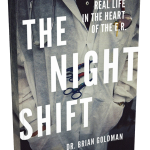“It is a positive and active anguish, a sort of psychical neuralgia wholly unknown to normal life.”
Darkness Visible: A Memoir of Madness is U.S. writer William Styron’s memoir about his descent into depression, and the triumph of recovery.
First published in December 1989 in Vanity Fair, the book grew out of a lecture that Styron originally delivered at a symposium on affective disorders at the Department of Psychiatry of Johns Hopkins University School of Medicine.
The title of the work comes from John Milton’s description of Hell in Paradise Lost:
No light; but rather darkness visible
Served only to discover sights of woe,
Regions of sorrow, doleful shades, where peace
And rest can never dwell, hope never comes
That comes to all, but torture without end
Still urges, and a fiery deluge, fed
With ever-burning sulphur unconsumed.
Styron begins his story in October 1985 when he flies to Paris to receive the prestigious Prix mondial Cino Del Duca. During this trip, the writer’s mental state begins to deteriorate rapidly. Using a mix of anecdotes, speculation, and reportage, Styron reflects on the causes and effects of depression, drawing links between his own illness and that of other writers such as Randall Jarrell, Albert Camus, Romain Gary, and Primo Levi, as well as U.S. President Abraham Lincoln and activist Abbie Hoffman.
Styron connects the onset of his depression with his sudden termination of his lifelong alcohol use, and argues that his condition was likely exacerbated by careless prescription of the drug Halcion. His depression culminated in a bout of intense suicidal ideation (though he never made an actual suicide attempt), which led to hospitalization and recovery. [From: Wikipedia.com]
“Depression is a disorder of mood, so mysteriously painful and elusive in the way it becomes known to the self — to the mediating intellect — as to verge close to being beyond description.”
A work of great personal courage and a literary tour de force, this bestseller is Styron’s true account of his descent into a crippling and almost suicidal depression. Styron is perhaps the first writer to convey the full terror of depression’s psychic landscape, as well as the illuminating path to recovery.
A great novelist describes his devastating descent into depression, taking the reader on an unprecedented journey into the realm of madness. The author of Sophie’s Choice was overtaken by persistent insomnia and a troubling sense of malaise–the first signs of a deep depression that would soon engulf his life and leave him on the brink of suicide. [From: Barnesandnoble.com]
“The pain is unrelenting, and what makes the condition intolerable is the foreknowledge that no remedy will come – not in a day, an hour, a month, or a minute. If there is mild relief, one knows that it is only temporary; more pain will follow. It is hopelessness even more than pain that crushes the soul. So the decision-making of daily life involves not, as in normal affairs, shifting from one annoying situation to another less annoying – or from discomfort to relative comfort, or from boredom to activity – but moving from pain to pain. One does not abandon, even briefly, one’s bed of nails, but is attached to it wherever one goes.”
In 1985, William Styron fell victim to a crippling and almost suicidal depression, the same illness that took the lives of Randall Jarrell and Primo Levi, Vincent Van Gogh and Virginia Woolf. That Styron survived his descent into madness is something of a miracle. That he manages to convey its tortuous progression and his eventual recovery with such candor and precision makes Darkness Visible a rare feat of literature, a book that will arouse a shock of recognition even in those readers who have been spared the suffering it describes. [From: Goodreads.com]
A meditation on Styron’s Sophie’s Choice serious depression at the age of 60, this essay evokes with detachment and dignity the months-long turmoil whose symptoms included the novelist’s “dank joylessness,” insomnia, physical aversion to alcohol previously “an invaluable senior partner of my intellect” and his persistent “fantasies of self-destruction” leading to psychiatric treatment and hospitalization. The book’s virtues – considerable – are twofold. First, it is a pitiless and chastened record of a nearly fatal human trial far commoner than assumed – and then a literary discourse on the ways and means of our cultural discontents, observed in the figures of poet Randall Jarrell, activist Abbie Hoffman, writer Albert Camus and others. Written by one whose book-learning proves a match for his misery, the memoir travels fastidiously over perilous ground, receiving intimations of mortality and reckoning delicately with them. Always clarifying his demons, never succumbing to them in his prose, Styron’s neat, tight narrative carries the bemusement of the worldly wise suddenly set off-course – and the hard-won wisdom therein. [From: Publishersweekly.com]
“At any rate, during the few hours when the depressive state itself eased off long enough to permit the luxury of concentration, I had recently filled this vacuum with fairly extensive reading and I had absorbed many fascinating and troubling facts”
Nearly 40 years ago, Styron published his first novel, Lie Down in Darkness, which revolved around the suicide of a young woman, Peyton Loftis. Now, he tells the short but very moving story of the deep depression which nearly overcame him in the summer of 1984. A successful middle-aged writer at the peak of his powers and acclaim, Styron was – seemingly inexplicably – struck by insomnia and a growing sense of malaise leading to hopelessness. He consulted a psychiatrist and was given high doses of the controversial drug Halcion for his insomnia, but his despair continued to increase until one evening he actually attempted suicide, only to be rescued by the playing of Brahms’s Alto Rhapsody in a video he was watching. He immediately had himself hospitalized, and after several weeks in the security and healing atmosphere of the hospital began to feel himself again. Expanded from a 1989 Vanity Fair article, this book is highly recommended. [A Review from Library Journal]
“A disruption of the circadian cycle – the metabolic and glandular rhythms that are central to our workaday life – seems to be involved in many, if not most, cases of depression; this is why brutal insomnia so often occurs and is most likely why each day’s pattern of distress exhibits fairly predictable alternating periods of intensity and relief.”
About The Author:
William Styron (1925-2006) , a native of the Virginia Tidewater, was a graduate of Duke University and a veteran of the U.S. Marine Corps. His books include Lie Down in Darkness, The Long March, Set This House on Fire, The Confessions of Nat Turner, Sophie’s Choice, This Quiet Dust, Darkness Visible, and A Tidewater Morning. He was awarded the Pulitzer Prize for Fiction, the Howells Medal, the American Book Award, the Legion d’Honneur, and the Witness to Justice Award from the Auschwitz Jewish Center Foundation. With his wife, the poet and activist Rose Styron, he lived for most of his adult life in Roxbury, Connecticut, and in Vineyard Haven, Massachusetts, where he is buried. [From: Amazon.com]
“the pain of severe depression is quite unimaginable to those who have not suffered it, and it kills in many instances because it’s anguish can no longer be borne. The prevention of many suicides will continue to be hindered until there is a general awareness of the nature of this pain.”
If you like this story, CLICK HERE to join the tribe of success-minded people just like you. You will love our weekly quick summaries of top stories, talks, books, movies, music and more with handy downloadable guides, cheat sheets, cliffs notes and quote books.















